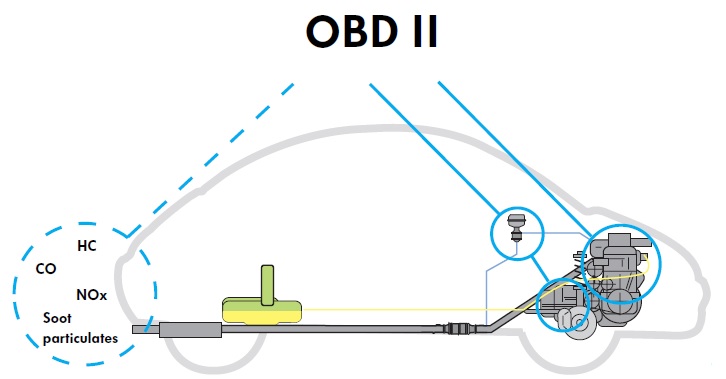OBD-II (CARB)
Since 1988 the California Air Resources Board (CARB) has tried everything within its power to curb atmospheric pollution by imposing statutory requirements. The concepts these efforts are OBD-I and OBD-II. The OBD-II is an improved version of the OBD-I.
The OBD-I standard was introduced by California Air Resources Board (CARB) in 1988. Until then, the compliance of the exhaust norms was only checked once at the vehicle registration.
The OBD-I standard defines, that the compliance of the exhaust norms has to be checked during the complete lifetime of a vehicle. For this purpose, all emission related systems of a vehicle and some additional important ECUs are monitored during the vehicle operation.
A fault code will be written into the fault memory and the Malfunction indicator lamp (MIL) will be lighted up, if an emission related error occurs.
OBD-II is the second generation of OBD-I and it expands the specification. In OBD-II, the diagnostic connector is specified, which wasn't part of OBD-I. The term Readiness was introduced in OBD-II to state, if an error could occur since the last erasure of the fault memory. Another feature of OBD-II is the extension of the list of DTCs. The Europe On-Board Diagnostics (EOBD) is a version of OBD-II used in Europe.
| OBD-I monitors: | OBD-II monitors: |
|---|---|
| the functional capability of sensors and actuators by measuring the voltage drops across components. | all functions of the input and output components such as OBD-I, e.g. short-circuit to positive, short-circuit to ground, open circuit |
| signals and components of functions affecting exhaust emissions for plausibility (e.g. catalytic converter, lambda probe) | |
| system functions (e.g. secondary air system) | |
| the entire drivetrain (e.g. emergency operation of automatic transmission) | |
1996 OBD-II came into force in all American Federal States. In Europe OBD-II was taken over from 2001 under the designation EOBD.
This applies to new cars with petrol engine from 2001, for passenger car diesel vehicles from 2003 and for truck diesel vehicles from 2005.
Many vehicles were capable of OBD-II before 2001, especially vehicles with big capacity engines which were also exported to the USA.

